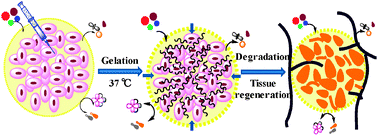Injectable and biodegradable hydrogels: gelation, biodegradation and biomedical applications
Abstract
Injectable hydrogels with biodegradability have in situ formability which in vitro/in vivo allows an effective and homogeneous encapsulation of

* Corresponding authors
a
CQM–Centro de Química da Madeira, MMRG, Universidade da Madeira, Campus da Penteada 9020-105 Funchal, Portugal
E-mail:
yulinli@uma.pt, lenat@uma.pt
Fax: +351-291705149/249
Tel: +351-291705150
Injectable hydrogels with biodegradability have in situ formability which in vitro/in vivo allows an effective and homogeneous encapsulation of

 Please wait while we load your content...
Something went wrong. Try again?
Please wait while we load your content...
Something went wrong. Try again?
Y. Li, J. Rodrigues and H. Tomás, Chem. Soc. Rev., 2012, 41, 2193 DOI: 10.1039/C1CS15203C
To request permission to reproduce material from this article, please go to the Copyright Clearance Center request page.
If you are an author contributing to an RSC publication, you do not need to request permission provided correct acknowledgement is given.
If you are the author of this article, you do not need to request permission to reproduce figures and diagrams provided correct acknowledgement is given. If you want to reproduce the whole article in a third-party publication (excluding your thesis/dissertation for which permission is not required) please go to the Copyright Clearance Center request page.
Read more about how to correctly acknowledge RSC content.
 Fetching data from CrossRef.
Fetching data from CrossRef.
This may take some time to load.
Loading related content
